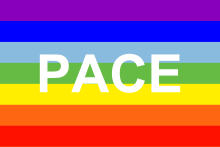Peace symbols: Difference between revisions
→Olive branch: m - took out irrevelent reference with no connection to the article |
|||
| Line 102: | Line 102: | ||
*[[Palm frond]] |
*[[Palm frond]] |
||
*[[V sign]] |
*[[V sign]] |
||
sfgjsrjsfgjsfghsfghsfghsfghsfhgsfhsfghsghsfghgfhsfhfghfghfghf |
|||
ghfghdfghfshsfghsdghhsghsfhsass |
|||
==Notes== |
==Notes== |
||
Revision as of 15:54, 20 May 2009
A peace symbol is a representation or object that has come to symbolize peace. Several different symbols have been used throughout history, of which the dove, olive branch, and the Campaign for Nuclear Disarmament symbol (the peace sign) are perhaps the best known. The peace sign is a popular symbol for teenagers to use while taking pictures.
Olive branch

In Greek tradition, olive branches are commonly used as peace symbols. The plant was said to be sacred to the ancient goddess of widsom, Athena. Olive branches, as well as the colour white, also appear on the flag of Cyprus.
In Judaism, Christianity, and Islam an olive branch is generally a sign for peace. The Torah, The Old Testament and The Qur'an describe a story in which a dove was released by Noah after the Great Flood in order to find land. The dove came back carrying an olive branch in its beak, telling Noah that the Great Flood had receded and there was land once again for Man. (Genesis 8:11).
The motif can also represent "hope for peace" and even a peace offering from one man to another, as in the phrase "extend an olive branch". Often, the dove is represented as still in flight to remind the viewer of its role as messenger.
Personification
In Greek and Roman mythology, the goddesses Eirene or Irene, Pax and Tranquillitas personified tranquility, security, calmness, peace.
Broken rifle

The broken rifle is a symbol widely identified with War Resisters' International and its affiliates, but actually it predates the foundation of WRI (in 1921). The first known example was the masthead of De Wapens Neder (Down with Weapons), the monthly of the International Antimilitarist Union in the Netherlands. The symbol spread, and in 1925 Ernst Friedrich, the founder of the Anti-Kriegs Museum in Berlin began using the symbol for badges, brooches, belt buckles and tiepins.[1][2] The symbol was also utilized by the band Crass, who included it in much of their artwork. This concept was later used by the band Anti-Flag as part of their "Gunstar" logo.
Shalom and Salaam

The Hebrew word "Shalom" (Hebrew: Template:Hebrew), and the Arabic "Salaam" (Arabic: Template:Rtl-lang) have been used as peace symbols. Shalom and Salaam literally mean "peace" and are cognates of each other, derived from the Semitic Triconsonantal of Ś-L-M (realized in Hebrew as Š-L-M and in Arabic as S-L-M). They have come to represent "Mideast peace" and an end to the Arab-Israeli conflict. Wall plaques and signs are sold with both the words and are featured in such Israeli peace songs such as "Salaam (Od Yavo Shalom Aleinu)."
Pace flag

In recent years, especially in connection with the 2003 Invasion of Iraq, there has been a surge in popularity of the Peace flag[citation needed], a series of seven rainbow colors (red on bottom) with the word PACE (Peace in Italian and Romanian, derived from the Latin word pax, pronounced pah-chay) boldly printed across the middle. The usage of the rainbow can either be tracked back to pacific coexistence of different people, or to the rainbow that God showed Noah at the end of the Biblical flood, as a token of the covenant that He made between Himself and mankind, that He would not again destroy the entire world with a flood (Genesis 9). The flag in its current shape appeared as early as September 24 1961, in an Italian peace march. It had previously featured a dove drawn by Pablo Picasso.[3] The flag is often flown from balconies in Italy by citizens opposed to the Iraq war. Its use has spread to other countries as well, with the Italian "pace" replaced with its translation in various other languages.
According to Amnesty International, producer Franco Belsito had produced only about 1,000 flags annually for 18 years, and suddenly had to cope with a demand in the range of millions.[4]
V-sign

The "V-sign", also called the "peace sign" and the "victory sign," is a hand gesture with the index and middle fingers open and all others closed, facing the viewer. Originally strictly a sign for victory, it developed into a peace sign during protests against the Vietnam War (and subsequent anti-war protests) and by the counterculture as a sign of peace. Because the hippies of the day often flashed this sign (palm out) while vocalizing "Peace", it became popularly known through association as the peace sign. Originally, however, its symbolic meaning was love; signing "love" and saying "peace" was a hippie anthem and mutual greeting.[citation needed]
John Lennon and his wife Yoko Ono later made "Peace and love" an ongoing theme in their relationship and public personae, even conducting a public "bed-in" (a parallel construction to a favorite hippie theme event during the 60s and early 70s, the "love-in") in Queen Elizabeth Hotel in Montreal, Canada, where they refused to leave their hotel bed.
The peace sign

This symbol (☮) was originally designed for the British nuclear disarmament movement. It was designed and completed February 21 1958 by Gerald Holtom, a professional designer and artist in Britain for the April 4 march planned by the Direct Action Committee Against Nuclear War (DAC) from Trafalgar Square, London to the Atomic Weapons Research Establishment at AldermastonChristan in England[5]. The symbol was later adopted by the Campaign for Nuclear Disarmament (CND), and subsequently became an international emblem for the 1960s anti-war movement and the counterculture of the time.
The symbol itself is a combination of the semaphoric signals for the letters "N" and "D," standing for Nuclear Disarmament. In semaphore the letter "N" is formed by a person holding two flags in an upside-down "V," and the letter "D" is formed by holding one flag pointed straight up and the other pointed straight down. These two signals imposed over each other form the shape of the peace symbol. In the first official CND version (which was preceded by a ceramic pin version that had straight lines, but was short lived) the spokes curved out to be wider at the edge of the circle, which was white on black.[6][7]


Holtom later wrote to Hugh Brock, editor of Peace News, explaining the genesis of his idea in greater depth: "I was in despair. Deep despair. I drew myself: the representative of an individual in despair, with hands palm outstretched outwards and downwards in the manner of Goya's peasant before the firing squad. I formalised the drawing into a line and put a circle round it."[7]

The peace sign flag first became known in the United States in 1958 when Albert Bigelow, a pacifist protester, sailed his small boat outfitted with the CND banner into the vicinity of a nuclear test. The peace sign button was imported into the United States in 1960 by Philip Altbach, a freshman at the University of Chicago, who traveled to England to meet with British peace groups as a delegate from the Student Peace Union (SPU). Altbach purchased a bag of the "chickentrack" buttons while he was in England, and brought them back to Chicago, where he convinced SPU to reprint the button and adopt it as its symbol. Over the next four years, SPU reproduced and sold thousands of the buttons on college campuses. By the late 1960s, the peace sign had become an international symbol adopted by anti-war protestors of the Baby Boomer generation. [8]
In Unicode, the peace sign is U+262E: ☮, and can thus be generated in HTML by typing ☮ or ☮. However, browsers may not have a font that can display it.
The original drawing of the CND is housed in the Peace Museum, U.K.[9] in Bradford, England, where a replica is on public display.
Alternate Use
The symbol's resemblance to a bird foot in a circle gave rise to alternative interpretations, ranging from plain mockery of "crow's foot" or "The footprint of the American Chicken" to a number of occult meanings, such as an upside down crucifix with the arms broken downward, suggesting the way that St. Peter was martyred (see Cross of St. Peter), or a representation of Jesus on the cross upside-down. This broken cross of Christianity was commonly conjectured as an antichrist symbol in the 1960s. Others have claimed that the symbol resembles a medieval sign known as "Nero's Cross" that represents Christian heresy.[10][11][12][13] Alternatively, some have suggested that the symbol is an inverted Elhaz rune, which would reverse the rune's meaning, according to the critics, from 'life' to 'death' (although the Elhaz rune is thought to mean elk[14]). Holtom's explanation of the genesis of the symbol and his first drawings of it, however, do not support those interpretations. Ken Kolsbum, a correspondent of Holtom's, says that the designer came to regret the symbolism of despair, as he felt that peace was something to be celebrated and wanted the symbol to be inverted.[15] The peace symbol was also believed by some to represent a swept-wing bomber, the type that would be used to deliver a nuclear weapon. In fact the United States 8th Air Force Museum sells decals of the top profile of a B-52 Stratofortress bomber, which strongly resembles the peace sign, with the words "Peace The Old Fashioned Way" or "Peace Through Superior Firepower" along the border of the decal.[16] Also, an icon nearly identical to the peace symbol was used by the German 3rd Panzer Division during World War II.[17]
Richard M. Spencer, late of the World Wildlife Fund, received much unexpected derision when he used the symbol for the marketing campaign "Have you hugged a panda today?" which featured a drawing of a panda holding a peace sign. The posters were made during the height of the Vietnam conflict and the use of the peace sign alienated many would-be supporters.
White Poppy

The White Poppy was first developed in 1933 by the Women's Co-operative Guild as an alternative to the Red Poppies used to commemorate British military dead. The newly-formed Peace Pledge Union (PPU) joined in distributing them in 1934, and white poppy wreaths were laid "as a pledge to peace that war must not happen again. In 1980, the PPU revived the symbol as a form of remembering the victims of war without glorifying militarism. In 1986 UK Prime Minister Margaret Thatcher expressed her "deep distaste" for the symbol.[18]
Other peace symbols

The crane is a traditional symbol for peace in Japan.[citation needed] Paper cranes are often folded, especially around the time of the New Year; one thousand cranes is a symbol of good luck.
Some unique items have come to symbolize peace. For example, the Japanese Peace Bell was a gift from the UN Association of Japan to the United Nations, presented to them in 1954. The bell remains at UN headquarters and is struck yearly, in remembrance for peace.
The Pax Cultura symbol, created by Nicholas Roerich, has also been used as a peace symbol.
Guernica, a painting by Pablo Picasso, has also been associated with pacifism. Although it was not conceived by the author as a representation of war's horrors, its depiction of the Nazi Bombing of Guernica is now considered an iconic anti-war statement.
See also
sfgjsrjsfgjsfghsfghsfghsfghsfhgsfhsfghsghsfghgfhsfhfghfghfghf ghfghdfghfshsfghsdghhsghsfhsass
Notes
- ^ Bill Hetherington, "Symbols of Peace", Housmans Peace Diary 2007
- ^ Other examples of the broken rifle symbol can be found at [1].
- ^ "Bandiera della pace".
- ^ "Det nytter!" (in Norwegian). Amnesty International. 2003-06-06. Retrieved 2008-03-22.
- ^ "A Piece of Our Time". Time Magazine. Retrieved 2008-04-02.
- ^ "The CND symbol". Hugh Brock Papers.
- ^ a b "The CND logo". Campaign for Nuclear Disarmament. Retrieved 2008-04-03.
- ^ Ken Kolsbun with Mike Sweeney. Peace: The Biography of a Symbol. National Geographic Books. ISBN 9781426202940. Retrieved 2008-08-28.
{{cite book}}: Unknown parameter|sate=ignored (help) - ^ The Peace Museum, Bradford
- ^ "The origin of the Peace Symbol". Docs Populi. Retrieved 2008-03-21.
- ^ Christian Resource Centre: Peace Sign
- ^ "Subdivision bans peace sign Christmas wreath". MSNBC. Associated Press. 2006-11-27. Retrieved 2008-03-22.
Homeowners association threatens to impose $25-a-day fine
- ^ Johnson, Kirk (2006-11-29). "Pro-Peace Symbol Forces Win Battle in Colorado Town". New York Times. Retrieved 2008-03-22.
{{cite news}}: Cite has empty unknown parameter:|coauthors=(help) - ^ Plowright, Sweyn (2006). The Rune Primer. LuLu. pp. 18, 123. ISBN 1847282466.
{{cite book}}: Cite has empty unknown parameter:|coauthors=(help) - ^ Westcott, Kathryn (2008-03-20). "World's best-known protest symbol turns 50". bbc.co.uk. Retrieved 2008-03-20.
{{cite news}}: Cite has empty unknown parameter:|coauthors=(help) - ^ 8AF Museum
- ^ "Panzer Divisional Markings". German Dress Daggers.
- ^ Bill Hetherington, "Symbols of Peace", Housmans Peace Diary 2007
External links
- The biography of the Peace Symbol by Ken Kolsbun - PeaceSymbol.com
- A tribute to the Peace Symbol and the Peace Sign - PeaceSymbol.org
- Peace symbols Part I - peace signs and images (author: Arash Vahdati)
- Peace symbols Part II - peace signs and images (author: Karan Reshad)
- What is the origin of the peace symbol? (from The Straight Dope)
- International Human Peace Sign
- Live peace symbols - in 30 country, 60 location
- Happy Birthday Peace - celebrating 50 years of Gerald Holtom's peace symbol
- World's best-known protest symbol turns 50 - BBC News
